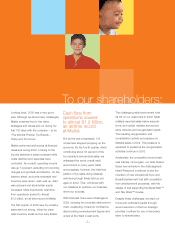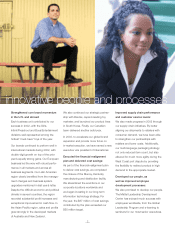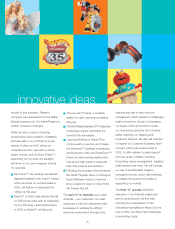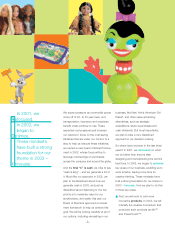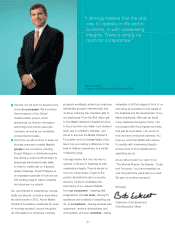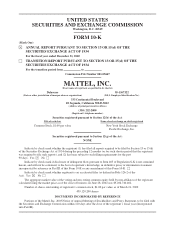Mattel 2002 Annual Report Download - page 3
Download and view the complete annual report
Please find page 3 of the 2002 Mattel annual report below. You can navigate through the pages in the report by either clicking on the pages listed below, or by using the keyword search tool below to find specific information within the annual report.
1
To our shareholders:
Looking back, 2002 was a very good
year. Although we faced many challenges,
Mattel remained true to the vision,
strategies and values laid out during my
first 100 days with the company – to be
“The World’s Premier Toy Brands –
Today and Tomorrow.”
Mattel performed well across all financial
measures during 2002. Looking to the
income statement, sales increased while
costs declined and expenses were
controlled. As a result, operating income
was up 14 percent, excluding non-recurring
charges and goodwill amortization. On the
balance sheet, accounts receivable and
inventory were down, cash was up, debt
was reduced and stockholder equity
increased. Most importantly, cash flow
from operations soared to almost
$1.2 billion, an all-time record at Mattel.
The first quarter of 2002 saw toy industry
sales start out strong, driven by clean
retail inventory levels and an early Easter.
But as the year progressed, U.S.
consumers stopped propping up the
economy. By the fourth quarter, which
contributes about 55 percent of the
toy industry’s annual retail sales, we
witnessed the worst overall retail
environment in many years. Most
encouragingly, however, the historical
pattern of toy sales doing relatively
well during tough times held up yet
again in 2002. That, combined with
our initiatives to optimize our business,
drove our success.
With that said, there were challenges in
2002, including the uncertain retail environ-
ment, weakening consumer confidence,
disconcerting unemployment figures and
unrest at the West Coast ports.
The challenging retail environment took
its toll on our customers in 2002. Most
retailers reported sales below expecta-
tions, and certain retailers announced
store closures and reorganization plans.
The resulting reorganization and
consolidation activity put pressure on
Mattel’s sales in 2002. This pressure is
expected to persist as the reorganization
activities continue in 2003.
Additionally, the competitive environment
was intense. Once again, our Girls division
faced new entrants in the dolls segment;
Infant/Preschool continued to see the
incursion of new educational toys; and
Boys/Entertainment had stiff competition
from entertainment properties, with the
release of toys supporting the Spider-Man™
and Star Wars™ movies.
Despite these challenges, we kept our
focus and optimized results through
sound execution of the four strategic
priorities I outlined for you in last year’s
letter to shareholders.
Cash flow from
operations soared
to almost $1.2 billion,
an all-time record
at Mattel.



